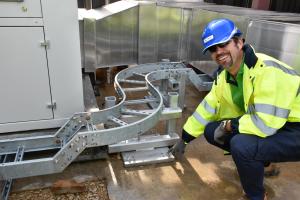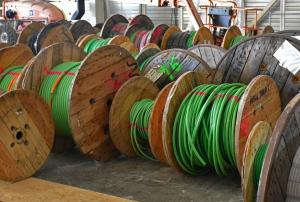Cable management
10,000 kilometres of arteries
3 Dec 2018
-
Kirsten Haupt
Put end to end, the cables that will crisscross the ITER scientific installation like arteries could reach the Peruvian capital Lima from the south of France—a total of 10,000 kilometres. One of the biggest challenges in their installation is the issue of sequencing—putting them in their place at the right time.
David Beltran, in charge of cable management, explains that the type of attachment for cable trays differs depending on the installation location. In nuclear buildings, supports are usually welded to embedded plates while in auxiliary buildings they can be anchored to steel structures and concrete slabs as shown above.
Not as impressive and visible as large components but equally essential to the operation of ITER are the cables that will wind their way across the facility, connecting components, providing power and transmitting data. After years of planning the organization, routing and integration of the cables, the first 250 km of cable have already been installed on site and the rhythm is accelerating.
The figure of 10,000 kilometres for all cables is an "educated guess," according to David Beltran—ITER's "cable guy" who leads a cross-departmental team in charge of cable management. "This estimate is based on the power consumption of auxiliaries in nuclear power plants. At First Plasma, more than 5,000 kilometres of cables will have been installed across the ITER site, with the remainder being laid until full operation in 2035.
Cables at ITER come in all sizes and types. More than a third are power cables; others are for instrumentation, diagnostics or data traffic. All cables are halogen-free to prevent the creation of harmful substances during an accidental fire, and have undergone qualification according to standard procedures and related international standards. About ten percent of all cables have fire resistant properties, meaning that they continue to be fully functioning in the event of a fire.
Cable drums point to ongoing wiring activities. In the Assembly Building, where cable-related activities began in February 2017, installation works are close to completion.
Depending on their location, cables need to meet additional requirements. In areas exposed to nuclear radiation for instance, they need to be able to sustain different accidental conditions such as radiation, high temperature and pressures. Cables for use in the vacuum vessel are designed to be compatible with this challenging environment.
Coordination and sequencing of the individual work phases constitute the biggest challenge according to Beltran—planning not only the order in which buildings need to be wired (many of them in parallel), but also the sequence of installation for structural supports, components and cables inside the buildings. "Accessibility is a big issue when planning cable installations. We need to be sure that cable trays and cables—once put in place—do not pose an obstacle for other installation activities," he explains.
The accumulation of such properties can make cable production challenging, says Beltran. "Some cables have an additional anti-rodent protection—their smell drives rats away," he says about cables that will cross underground tunnels to connect the different buildings on the ITER worksite.
Coordination and sequencing of the individual work phases constitute the biggest challenge according to Beltran—planning not only the order in which buildings need to be wired (many of them in parallel), but also the sequence of installation for structural supports, components and cables inside the buildings. "Accessibility is a big issue when planning cable installations. We need to be sure that cable trays and cables—once put in place—do not pose an obstacle for other installation activities," he explains.
Big deadlines are approaching for wiring activities. By the end of the year, several buildings including the Assembly Building and the Magnet Power Conversion buildings, must be fully equipped with cables and related electrical building services such as HVAC, power sockets, switches and lights. The commissioning of electrical systems will begin in January in the Assembly Building, so that all building services are in full operation when the first vacuum vessel sector arrives from Korea in the middle of next year.
In the meantime, the telltale signs of cable installation—stacks of cable trays and cable drums outside of the Cryoplant Building—pinpoint the upcoming cable installation priorities on the ITER worksite.



